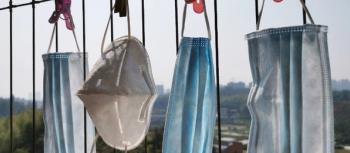
Mask Decontamination Endangers Healthcare Workers, Nurses’ Unions Charge
N95 decontamination must meet 3 criteria. It needs to: inactivate the pathogen, it can’t damage or degrade the N95 in any way, and it should not introduce an additional hazard to the healthcare worker.
The use of decontaminated masks puts infection preventionists and other healthcare professionals at risk, two nurses’ unions said today. The Massachusetts Nurses Association (MNA) and National Nurses United (NNU) asked an expert to review a report by the Mass General Brigham (MGB) Center for COVID Innovation that deals with the efficacy of decontaminated masks. That expert, Richard Peltier, PhD, has serious doubts that decontaminated masks can keep healthcare workers safe.
“In my opinion, there is no doubt of the many open questions to decontaminated masks, but I fear there are some who simply do not want to know the answers to the questions we are asking.,” Peltier said in a
Peltier said he felt disheartened that independent scientific inquiry is disregarded. Peltier applied his independent inquiry to a
At the end of March, Battelle announced that its machines can decontaminate 80,000 N95 respirators a day, a breakthrough hailed as a
On its website, MGB says that its mission is to “facilitate the development of new innovations that flatten the COVID-19 curve and protect frontline clinical staff across the MGB community and beyond.”
But Peltier said that the desire for innovation might encourage the dismissal of data that doesn’t gel with an outcome everybody wants—more workable N95s.
“N95 respirators used by clinical workers are surprisingly complicated safety devices and are really meant to be disposable—under ordinary circumstances, you’d use it once and toss it in the trash,” Peltier said. “But these are not ordinary times and hospitals are grasping at solutions to find ways to extend their limited supplies to keep workers safe.”
Peltier took a look at the data on vaporized hydrogen peroxide effects on five respirators and has some concerns. “Unfortunately, respirator decontamination was rush-approved by the FDA with no further safety testing to measure whether these respirators continue to work as they were designed,” Peltier said. “In fact, none of these respirators were designed to be reprocessed at all.
“At the same time, there are many different decontamination methods being used by clinical centers across the U.S., and we just do not know whether these masks continue to protect wearers adequately. Of the limited data that is available, almost all of it comes from the decontaminating companies themselves, or the hospital groups that have signed on to use these services.”
Jane Thomason, the lead industrial hygienist with NNU, also laid out her case against decontamination of respirators, saying that the process must meet 3 criteria. It needs to:
inactivate the pathogen, it can’t damage or degrade the N95 in any way, and it should not introduce an additional hazard to the healthcare worker.
“We have not seen any decontamination method meet these three criteria; in fact, several methods currently in use may be harmful by one or more criteria,” Thomason said. “Decontamination and reuse of N95 respirators endangers the health and safety of nurses and other healthcare workers.”
Thomason added that “instead of seeking safer alternatives, hospitals and our state and federal governments have rushed to embrace untested, dangerous decontamination and reuse policies. Hospitals have largely ignored more protective, safely reusable respirators such as powered air-purifying and elastomeric respirators, and our state and federal governments have refused to mandate increased production of N95 respirators and other PPE.”
Newsletter
Stay prepared and protected with Infection Control Today's newsletter, delivering essential updates, best practices, and expert insights for infection preventionists.






